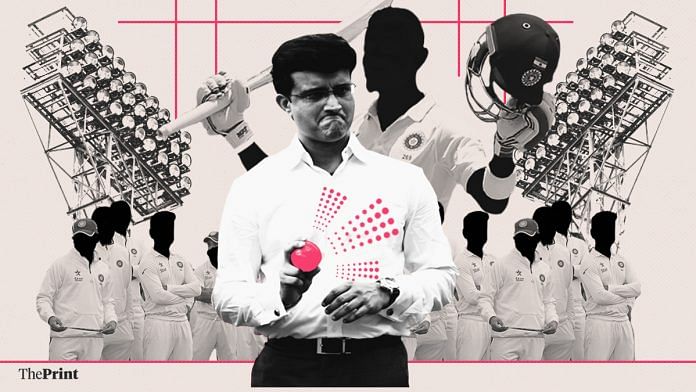India finally made its debut in pink-ball cricket Friday. The country’s first day-night Test match kicked off against Bangladesh at Kolkata’s Eden Gardens. Newly appointed BCCI president Sourav Ganguly is widely credited for ushering in the pink-ball system despite India’s resistance to it for four years. Test viewership continues to witness a decline in India and elsewhere.
ThePrint asks: Will Indian cricket moving into pink ball era under Sourav Ganguly revive Test cricket?
Not day-night gimmickry but competitive cricket on good pitches will revive Test cricket in India

Jaideep Verma
Writer-director and founder of Impact Index
The crowd at Eden Gardens in Kolkata has come to experience a novelty in Test cricket – watching a match under floodlights. That’s all there is to it and not about the quality of cricket since the visiting Bangladesh team is possibly weaker than many Indian domestic teams. It is also not about having Bangladeshi players in Kolkata because previous Tests between the two teams at the Eden Gardens had failed to attract full houses.
But novelties happen just once.
Day-night Test is a good idea, but it can become a disaster in India given the dew problem. In such circumstances, this new format will be a mockery of Test cricket. We have to wait and see if that happens here, but it will definitely be a problem in some other venues. So, I am not sure if the day-night format is a long-term solution to the dwindling viewership for Test cricket, unless we identify venues where post-sunset dew does not affect conditions too much.
What will revive Test cricket in India is high-quality competitive cricket on good pitches, not gimmickry.
Sourav Ganguly has done great by pushing through day-night Test, and pink ball will help in short term

Ayaz Memon
Sportswriter
The expectation is that the pink ball-era will revive Test cricket, which is witnessing a slump in viewership across the world.
In India, T-20 and IPL matches attract huge crowds. Even though India has shown immense growth in Test cricket, it has not attracted a good number of spectators. The main issue has been to get people in the stands and not on social media.
Day-night Test is a spectacle that will definitely help in the short term. It has an inbuilt advantage since it is played at a certain time of day. People can attend schools, colleges, work and still make it to the last two sessions of the Test match.
Someone had to revive it since India had been reluctant to take the plunge. It needed a player-turned-administrator rather than just an administrator. I think BCCI President Sourav Ganguly has done a great job by pushing through the agenda so rapidly. However, it won’t be a cakewalk and India’s cricket administration will really have to hard-sell it in the market.
It is really hard to tell if it would impact India’s performance since our players haven’t played enough matches like these.
On the question of pink balls not working for spin bowlers, Indian batsmen have not played Test matches with the pink ball either. Their performance can’t be solely determined by the pink ball, it also depends on the quality of the opposition. Moreover, the cricket pitch in Kolkata is different from that in Delhi or Mumbai.
This is just an opportunity to attract audiences. How you maintain it is the key issue.
To make pink ball the be-all and end-all of cricket, especially Test cricket, is not fair

Norris Pritam
Sports columnist and senior freelance journalist
A mere cricket ball is making more news than Pink Floyd. BCCI president Sourav Ganguly may have his reasons (read commercial) to turn the craze about India’s debut in pink-ball cricket into a tamasha. But others who are making noises perhaps don’t know that three years ago, the pink ball was used in a day-night Duleep Trophy match in Noida.
Prior to that, the pink ball had made its debut in the match between Australia and New Zealand at Adelaide in November 2015. So far, 11 Test matches have been played with the pink ball.
The colour of the pink ball apart, it is the black seam on it that deserves more discussion and scrutiny. In a day-night Test match, the thread being black in colour can create problems for the batsmen. But to make pink ball the be-all and end-all of cricket, especially Test cricket, is not fair.
Indian cricket captain Virat Kohli was right when he said at a press conference in Kolkata “this can be a one-off thing. It should not, in my opinion, become a regular scenario”.
What Kohli actually said quite diplomatically was that there should be no meddling with Test cricket.
There are several other ways to promote or popularise a sport but to make a mockery of it is not desirable. A hugely popular sport like cricket should be left alone.
Pink ball is a momentary celebration. Focus must return to game to make Test cricket sustainable

Anand Vasu
Sports journalist
The buzz generated around the pink ball Test match in Kolkata has been immense. The manner in which the BCCI quickly geared up for the historic event, helped by the fact that the match was staged at the home ground of the board’s new president Sourav Ganguly, the enthusiasm with which the Cricket Association of Bengal took to the opportunity, and finally the passion with which Kolkata and its inimitable inhabitants owned the occasion is nothing short of spectacular.
But, as great a spectacle as this is, and this is what it is at the moment, its impact on Test cricket in the long run, and indeed its desirability, will only be revealed in time. If day-night Test cricket can genuinely bring in bigger audiences – more than 40,000 people turned up to watch the match against Bangladesh on the first day, unheard of for a Test in India in recent memory –and make the format more attractive to broadcasters, it can only be a good thing.
But, cricket, especially Indian cricket, has a long history of killing the goose that lays golden eggs. For the moment, the pink ball Test is something to celebrate, just for the sheer novelty of it. But in the long run, cricket has to be the focus if Test cricket is to be made sustainable.
Whatever the pink colour of the ball does, it will be for all sides. So, what are we hyperventilating about?

Shekhar Gupta
Editor-in-Chief and Chairman, ThePrint
The debate over the use of the ‘pink’ ball in the new day-night format for Test cricket is vacuous, pointless or, in the language more familiar on India’s maidans, totally faltu. Will it help pace or spin, can batsmen pick the seam under lights, will this bring about fundamental changes to the way the game is played, is all pointless, and merely an excuse for prime time bloviators? Whatever the colour of the ball does, it will be common to all sides – batsmen, bowlers, fielders, umpires. So, what are we hyperventilating about?
Mass sport has to change and evolve with times. All sport does, at least all that is successful. People were not coming to watch Test cricket that initially stretched over six days — with one rest day in the middle. That was dropped first.
Then we started covering the pitches to minimise loss of time. Covers for the bowlers’ run-ups followed, more of the ground and super-soppers to get the turf ready for play as soon as possible after rain. Lights came around the same time, as did protective gear: for batsmen, wicket-keeper and also close-in fielders. And the big, big reform: a minimum of 90 overs in a full day or 15 overs for every completed hour. Remember how in the ’70s and ’80s teams got away bowling much fewer overs a day to secure draws.
This is by no means an exhaustive list of all the changes. Much else has changed, including the bats. There are different kinds of balls too, with comparative merits of Kookaburra, SG and Dukes being constantly debated. All this adds to the romance of cricket, or makes for that oldest cricketing metaphor: glorious uncertainties.
Mass sport is played for fans. In the modern era, for paying ‘janata,’ whether on the ground or television screens. All major sports have changed to improve spectator delight. Hockey switched fully to artificial surfaces, carbon-graphite sticks, radical reduction in fouls and thereby referee-whistle interruptions, TV referrals, and now four quarters instead of two halves. Badminton, tennis, table tennis – all have undergone changes with the same objective: giving the paying fans more value for their time and money.
Cricket, if anything, has been slow and hesitant to change. But empty stadiums for Test cricket, still the finest and the most complete form of ‘real’ cricket, have caused alarm. I have listed the many changes made already. The day-night format is just a way to give people the joy of watching cricket after their work hours. The pink ball is just an optical necessity for a game adjusting to different light conditions in the course of the same day.
Its novelty value has already brought the crowds, and just as well that it is at Kolkata, the sportiest of our cities. Sourav Ganguly’s BCCI turned the city pink, Bangladesh’s Sheikh Hasina Wazed turned out in a pink sari too. A brilliant new cricketing brand is being built. Of course, too bad for Bangladesh fans their team didn’t exactly start out on a stirring note after winning the toss.
Also read: How Sourav Ganguly became BCCI president, with some help from BJP
By Kairvy Grewal, journalist at ThePrint







Is Bangladesh sent 12 players to bat in the kolkatta test?